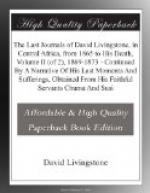25th March, 1873.—Nothing earthly will make me give up my work in despair. I encourage myself in the Lord my God, and go forward.
We got off from our miserably small islet of ten yards at 7 A.M., a grassy sea on all sides, with a few islets in the far distance. Four varieties of rushes around us, triangular and fluted, rise from eighteen inches to two feet above the water. The caterpillars seem to eat each other, and a web is made round others; the numerous spiders may have been the workmen of the nest. The wind on the rushes makes a sound like the waves of the sea. The flood extends out in slightly depressed arms of the Lake for twenty or thirty miles, and far too broad to be seen across; fish abound, and ant-hills alone lift up their heads; they have trees on them. Lukutu flows from E. to W. to the Chambeze, as does the Lubanseusi also. After another six hours’ punting, over the same wearisome prairie or Bouga, we heard the merry voices of children. It was a large village, on a flat, which seems flooded at times, but much cassava is planted on mounds, made to protect the plants from the water, which stood in places in the village, but we got a dry spot for the tent. The people offered us huts. We had as usual a smart shower on the way to Kasenga, where we slept. We passed the Islet Luangwa.
26th March, 1873.—We started at 7.30, and got into a large stream out of the Chambeze, called Mabziwa. One canoe sank in it, and we lost a slave girl of Amoda. Fished up three boxes, and two guns, but the boxes being full of cartridges were much injured; we lost the donkey’s saddle too. After this mishap we crossed the Lubanseusi, near its confluence with the Chambeze, 300 yards wide and three fathoms deep, and a slow current. We crossed the Chambeze. It is about 400 yards wide, with a quick clear current of two knots, and three fathoms deep, like the Lubanseuse; but that was slow in current, but clear also. There is one great lock after another, with thick mats of hedges, formed of aquatic plants between. The volume of water is enormous. We punted five hours, and then camped.
27th March, 1873.—I sent canoes and men back to Matipa’s to bring all the men that remained, telling them to ship them at once on arriving, and not to make any talk about it. Kabinga keeps his distance from us, and food is scarce; at noon he sent a man to salute me in his name.
28th March, 1873.—Making a pad for a donkey, to serve instead of a saddle. Kabinga attempts to sell a sheep at an exorbitant price, and says that he is weeping over his dead child. Mabruki Speke’s hut caught fire at night, and his cartridge box was burned.
29th March, 1873.—I bought a sheep for 100 strings of beads. I wished to begin the exchange by being generous, and told his messenger so; then a small quantity of maize was brought, and I grumbled at the meanness of the present: there is no use in being bashful, as they are not ashamed to grumble too. The man said that Kabinga would send more when he had collected it.




